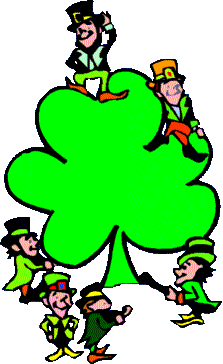March-May 1999 The Sabbath Sentinel Wearing the Greenby Richard C. Nickles
The Truth of history is not well known. Patrick was not Irish, but a Scottish missionary to Ireland. He was not a Sunday keeping Roman Catholic Trinitarian, but a Sabbath-keeper opposed to the Trinity concept. Seventh Day Baptists have long been aware of the facts concerning Patrick. The book, Seventh Day Baptists in Europe and America (1910), reports that the Christian Church in Ireland was founded soon after the death of Christ by disciples of the Asian Churches. Columba's establishment of a Sabbath-keeping community in the island of Iona was the result of Patrick's teaching. Celtic Ireland was unattached to Rome until at least 1155. Some Irish Sabbath-keepers remained until the nineteenth century. According the Seventh-day Adventist historian Leslie Hardinge, in his book The Celtic Church in Britain, Patrick (ca. 387-463) evangelized Ireland, founding over 300 churches and baptizing over 120,000 converts. However, Christianity existed in Ireland long before Patrick's time. Many Celtic believers in Ireland were Arians (anti-Trinitarian). They kept the Sabbath from sundown to sundown. They were known to be Quartodecimans, observers of the annual Christian Passover once a year, on the fourteenth day of the first month in the spring. They eschewed unclean meats. Their ministry had to be recognized, even by outsiders, to be honest and above reproach, and celibacy was not practiced until later times. Celtic services included a recitation of the Decalogue. Wherever Patrick went, he left an old Celtic law book, Liber ex Lege Moisi (Book of the Law of Moses), along with other books of the Gospel. The Liber begins with the Decalogue, and continues with selections from the Torah. Citing Exodus 23:1-19, Part 4 of the Liber emphasizes that the Sabbath is to be kept, along with three annual feasts. Part 5 notes that according to Exodus 31:13, the Sabbath is a sign of God's people. Patrick practiced laying on of hands after baptism for the receipt of the Holy Spirit. While "St. Patrick" is revered as a Roman Catholic saint, his writings appear to place him squarely in the Sabbath-keeping Messianic tradition. St.Patrick was one of us! The Celtic Church in Britain, 265 pages, is available from the BSA for $9.00. This is one of the most interesting books you will ever read. It is appropriate that the book's cover is green. Green is the color of the Irish; green is also the color of the Sabbath. Green invokes feelings of abundant crops and peace, which the Sabbath day pictures and exemplifies. Historically, Irish Celtic Sabbath-keepers have played a major role in the preservation of the practice of Sabbath-keeping in continental Europe and beyond. Celtic Irish missionaries evangelized Europe during the Dark Ages. So, the next time someone asks you on St. Patrick's Day if you are wearing green, tell them, "Yes! I keep the seventh day Sabbath, just like Patrick of Ireland did!" Let us continue to wear the green. NOTE: Chris Barr of the Little Children of Jesus Christ, a Sabbatarian group in Pocahontas, Arkansas, showed me a copy of an ad his Church placed in their local newspaper. This ad brought a tremendous response to the group's web site. St. Patrick's "DAY" -- Come join with us to worship JESUS as did the Irish Patrick of old on this coming Sabbath, the Seventh Day, commonly called "Saturday." Like other Christian Irishmen of his time, Patrick was a Sabbath-keeper, kept Passover and the dietary laws of Moses, and stressed keeping the Law of God. TSS |
 March 17 is commonly celebrated as St. Patrick's Day, who,
according to Roman Catholics, is the patron saint of Ireland,
the Emerald Island. Thus, green has come to be associated with
St. Patrick. When I was a child, unless I wore something green
on St. Patrick's Day, I was likely to get myself pinched. Many
adults use the occasion to engage in reveling and drinking, green
beer and whiskey being the accepted manner to celebrate Irish
history.
March 17 is commonly celebrated as St. Patrick's Day, who,
according to Roman Catholics, is the patron saint of Ireland,
the Emerald Island. Thus, green has come to be associated with
St. Patrick. When I was a child, unless I wore something green
on St. Patrick's Day, I was likely to get myself pinched. Many
adults use the occasion to engage in reveling and drinking, green
beer and whiskey being the accepted manner to celebrate Irish
history.